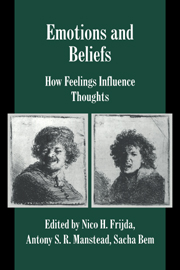Book contents
- Frontmatter
- Contents
- Contributors
- 1 The influence of emotions on beliefs
- 2 Feeling is believing: Some affective influences on belief
- 3 Beliefs through emotions
- 4 The sentiments and beliefs of distributed cognition
- 5 Feeling is believing? The role of processing strategies in mediating affective influences on beliefs
- 6 The formation of beliefs at the interface of affective and cognitive processes
- 7 Anxiety, cognitive biases, and beliefs
- 8 A cognitive dissonance theory perspective on the role of emotion in the maintenance and change of beliefs and attitudes
- 9 Relationship beliefs and emotion: Reciprocal effects
- Index of authors
- Index of subjects
- Studies in Emotion and Social Interaction
5 - Feeling is believing? The role of processing strategies in mediating affective influences on beliefs
Published online by Cambridge University Press: 10 March 2010
- Frontmatter
- Contents
- Contributors
- 1 The influence of emotions on beliefs
- 2 Feeling is believing: Some affective influences on belief
- 3 Beliefs through emotions
- 4 The sentiments and beliefs of distributed cognition
- 5 Feeling is believing? The role of processing strategies in mediating affective influences on beliefs
- 6 The formation of beliefs at the interface of affective and cognitive processes
- 7 Anxiety, cognitive biases, and beliefs
- 8 A cognitive dissonance theory perspective on the role of emotion in the maintenance and change of beliefs and attitudes
- 9 Relationship beliefs and emotion: Reciprocal effects
- Index of authors
- Index of subjects
- Studies in Emotion and Social Interaction
Summary
Introduction
Beliefs are stable, enduring cognitive representations that have a fundamental influence on the way people perceive, construct and interpret the social world. Recently, Ajzen defined beliefs as “people's information about themselves and about their social and non-social environment” (1995: 88–89). However, beliefs are also intensely personal, idiosyncratic creations. George Kelly (1955) argued over forty years ago that any meaningful understanding of social life must include a careful analysis and understanding of the personal belief systems, cognitive representations, or, in Kelly's terms, “personal constructs” that make the world intelligible and predictable for most of us. Unfortunately, social psychologists were relatively slow to follow Kelly's programatic call for the intensive study of the content and structure of individual construct systems. On the positive side however, recent social cognition research revealed much about the processes and mechanisms that are involved in the formation, maintenance and evolution of belief systems.
For Kelly, personal constructs were intensely personal, affect-laden ways of seeing the world. In contrast, much of social cognitive theorizing treated beliefs as essentially cold knowledge structures devoid of emotional loading. This chapter will argue that affective states are intimately involved in the creation, use and maintenance of all cognitive representations and beliefs about the world. It will be suggested that affect, including relatively mild and innocuous mood states that are with us all the time, can have a marked influence on our beliefs and judgments, as well as our social behaviors.
- Type
- Chapter
- Information
- Emotions and BeliefsHow Feelings Influence Thoughts, pp. 108 - 143Publisher: Cambridge University PressPrint publication year: 2000
- 48
- Cited by



